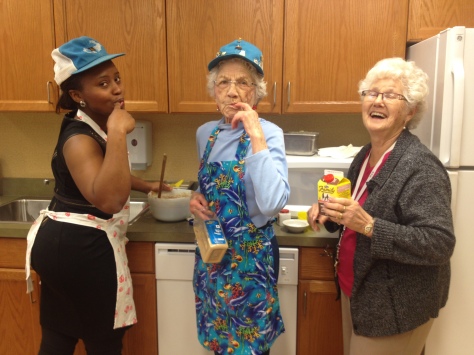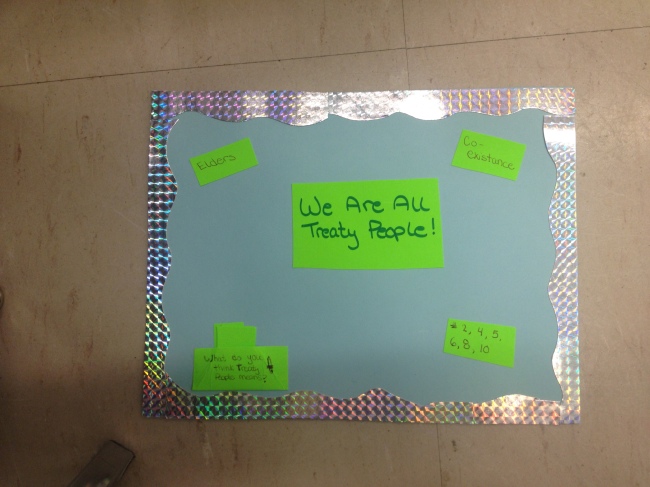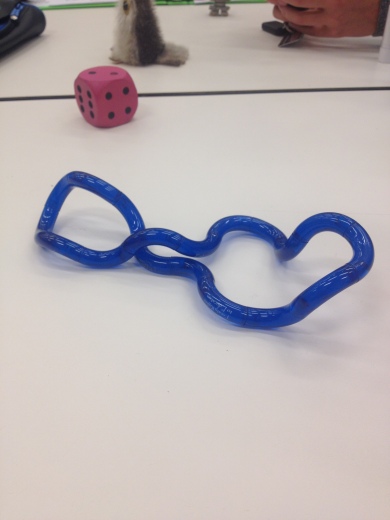Section 1 Unit Plan and Lesson Planning:
1. Teaching “What Makes a Difference” in grade one this resource is extremely helpful. This website has material that can be used over multiple lessons. It directly connects to outcomes that fall under dynamic relationships.
http://teachers.net/lessons/posts/4764.html
2. Elders
Elders are an integral part of First Nations culture. Elders provide us with amazing stories and great knowledge and wisdom. An Elder can identify the treaty areas and/or bands across Canada and sacred spaces for the First Nations people. In addition, Elders would be a crucial resource for determining and learning about where pre-contact First Nations groups lived, as it would be hard to map due to their mobile lifestyle. Elders are the most knowledgeable people in First Nation’s culture and are easy to access for teachers. Every School division has connections to different Elders. Getting in touch with an Elder or a cultural liaison is a first step that you will not regret.
Elder Mike Pinay – Regina Catholic School Division
Elder Neil Starchild – Regina Public School Division
George Favel – Cultural Liaison for Regina Public School Division
3. Brain Breaks
Brain breaks are a phenomenal tool to allow students to take a break. A few breaks that I think are a great ideal to implement into social studies are silent ball and singing! Silent ball can be played in many ways. One way to play it is have all students stand beside their desk. When they receive the ball they have to say a word that they associate with say geography. This can be used with any social outcome!
When it comes to singing, it gives the students a break from the task at hand and it is fun! Students can sing the continent song, or make up a song about the treat land or whatever they happen to be learning about at that time!
4. Encyclopedia of Saskatchewan
The encyclopedia of Saskatchewan is a great resource and extremely user friendly! It includes everything you want to know about Saskatchewan geography (useful for the grade 4 social curriculum). It includes: place, region & identity, location, the physical environment, historical geography, as well as: human geography à including population, economic geography, culture & landscapes, and a conclusion.
Not only this, but you can choose specific places in Saskatchewan à lakes, towns you’ve never heard of, as well as research findings such as: air pollution, meteorite discoveries, mineral resources, and flood control, among many others (could have been useful this summer).
Though this resource is great for geography, it offers MANY other subjects that would be extremely useful for you and your classroom such as:
Aboriginal (First Nations and Metis) Agriculture, Food Arts, Culture Business, Industry Communities, Geography, Health History, Labour Law, Justice Military, Order of Canada Recipients Politics, Government Population Religion, Philosophy, Saskatchewan Order of Merit Recipients, Science and Technology, Social Policy Sports and Recreation Transportation.
5. Atlas
Atlases are great resource for many reasons. Whether they are conventional or digital, they hold most information a student would need when learning about geography. World Atlas have facts, flags and maps including every continent, country, dependency, exotic destination, island, major city, ocean, province, state & territory, regions, elevation and much more. The Atlas is also a useful tool because it can be adapted to fit any age group. The conventional Atlas is useful because most schools will have them on hand for students to use. If they are not available at the school there are many public libraries that will have them on the shelves. The digital Atlas can come in many forms as well. It is very handy to have a world Atlas online so you can bring it up on a projector while teaching a lesson so all students can see. They are also helpful because the student can access it anywhere, they do not necessarily have to be in school to use this resource.
Section 2 Key Resources:
1. This video displays grade two students singing the continent song. Along with singing the song the students have come up with actions to do with the words so that it is easier to remember. We used this in our grade ¾ class when we were talking about continents. The students loved the catchy song and were able to recite the continents without looking after just two times of playing the song. It would also be a great lesson to make your own class video.
http://hippohoorayforsecondgrade.blogspot.ca/2014/07/continentsocean-song-and-video.html
2. This website is a great resource when teaching geography. This website can be used from grade two to grade five when teaching most indicators under the dynamic relationships category. This is a fun tool to use in place of a textbook. Students will be working hands on to learn and they are also building their internet skills by working with technology. There are eleven chapters that are covered on throughout this online textbook. Along with the information there is a wide variety of games to pick from to add to the students learning.
http://www.kidsgeo.com/
3. Timeline Eons FREE – apple app for Ipads and Iphones
This app has very interesting and informative timelines of important events, going all the way back to 14,000,000,000 years ago! It includes pictures, descriptive text, and bars showing how long certain periods in history lasted. This is a great resource for students to explore to see what they can find. This would work awesome as an inquiry project. This app will help develop the students thinking and understanding. This app could also be used to find information then use it in an English class to write a narrative about what they found.
4. Go Explore Canada– apple free app for Ipads and Iphones
Where to go, what to do, where to stay, where to eat, where to play and just ‘where the heck am I?’
GoExplore Canada gives you a completely different way to see this great country from Atlantic to Pacific, including the great Canadian Arctic. The totally interactive Google Map holds it all together. You zoom out for the big picture or zoom into any city, town, village or spot in the vast Canadian nation. It contains thousands of Canada’s top attractions and natural wonders.
This resource is a great tool for teaching geography at any age. It is easy to navigate for children. It is even useful for adults who are traveling. It has top rated hotels, restaurants, transportation information and much more!
I did my group presentation on geography and I wish I would have known about this app beforehand! I can’t wait to use it with my students in the years to come.
5. Raz Kids
Raz Kids is an online resource that has hundreds of e-books for students to listen to. This site also keeps record of the student’s progress so it is a great tool for the teacher to have. By using Raz kids you are able to hit multiple outcomes from different areas of study. There are books that address issues relates to heal studies, social studies, science, treaty education, and even math. This site helps students with their literacy development.
Section 3: Instructional Strategies
1. Group Projects
Getting students to work in groups is a wonderful way to allow shared learning. The students will compare and contrast perspectives; practice high-level cognitive skills (i.e., application, analysis, synthesis, evaluation); develop meta-skills such as leadership, communication, conflict resolution; strategize and plan how to tackle complex problems and distribute work.
2. Service Learning
Students will work on interesting, real-world problems. They will have opportunities to apply their disciplinary knowledge in new situations where they can help others. If carefully planned students can have a rich educational experience. This is a way of learning that is meaningful and students would benefit
While at the SAFE conference I learned about an EcoJustice program based out of Saskatoon. EcoJustice is a grade 8 environmental, adventure program housed out of Saint Edward School. EcoJustice is an approach that analyzes the increasing destruction of the world’s diverse ecosystems, languages and cultures by the globalizing and ethnocentric forces of Western consumer culture. In EcoJustice, students become aware of important global issues and actively pursue local social justice causes. Their program, through real life connections with the community and environment will develop students intellectually, socially, physically and spiritually while also enhancing their self-esteem and citizenship skills. This program’s relevant and engaging experiential learning helps students to truly understand and critically evaluate real community issues that affect us all individually, provincially and globally as Canadians and Catholics.
I would love to be able to give my students an opportunity like this. I would like to try to implement service learning into my classroom as much as possible. Personally, I learn way better when I know I am making a difference and working hands on.
3. Discussions
Discussions can be an excellent strategy for enhancing student motivation, fostering intellectual alertness, and encouraging independent habits. They create opportunities for students to practice and improve a number of skills, including the ability to express and defend view points, consider different points of view, and evaluate evidence.
While discussions provide avenues for exploration and discovery, leading a discussion can be anxiety-producing (as we have noticed in class). There are many ways that we have talked about to help ease this anxiety. Some of these strategies include: having a talking stone to pass around, leave the question open to the floor, chose questions that allow for expansion, have different people facilitate the circle/discussion and splitting the class up into groups to argue both sides of the posed question.
By using discussion based learning students are able to develop their thinking by thinking contextually, thinking creatively and thinking critically.
4. Case Studies
Case studies are stories. They present realistic, complex, and contextually rich situations and often involve a dilemma, conflict, or problem that one or more of the characters in the case must negotiate.
Case studies can be an effective teaching tool in any number of subjects. They also give students practice identifying the factors of a problem, recognizing positions, evaluating courses of action, and arguing different points of view. Students are also develop their social responsibilities by using moral reasoning.
Case studies can be used at any age level. When teaching younger grades the case studies can be simple and the use of role playing can be implemented for students to understand fully. As the students age and mature there is room for more complex case studies. The stories can be current events for students to be exposed to social justice issues.
5. Writing
By implementing writing into lessons students are not only working on social studies, but they are also working on their EAL skills. This ensures that you hit two outcomes in your lessons. Writing also develops systematic relationships among ideas; application, analysis, synthesis and evaluation. Writing allows students to reflect on own thinking.
When students write throughout the lesson they will develop their Literacy skills. They will build their knowledge related to various literacies, explore and interpret the world using various literacies and express understanding and communicate meaning using various literacies.
Section 4: Classroom Management Strategies
1. Give me 5
I used this strategy during my pre-internship. I liked using it because our cooperating teacher used it too so the students knew how to respond when we did it. I would stand at the front of the class and say “give me five” with my hand above my head. I would slowly and quietly count from five to one and then expected the students to be quiet and listen.
5- eyes on the speaker
4-quiet
3-be still
2-hands free
1-listen
2. Rain Stick
This is the only strategy I did not try during my pre-internship out of this list. I think it is a creative idea to use. It can also be used for lessons about the origin of rain sticks and even make rain sticks with the students. Throughout my pre-internship I noticed that our cooperating teacher didn’t use a rain stick, but she did use bells. She would use them when it was time to switch from one centre to another.
3. Clapping
This was mainly used by my intern partner and me in the classroom. Most times we would stick with the Give me 5 strategies, but when the students were doing group work sometimes it was a lot easier to come back as a group by clapping a pattern. Because we only used this occasionally the students really responded well to this. They really like to make up their own rhythm too so Kristi and I would let different students make up the rhythm for the class. It was a great way to grab attention, but yet keep students engaged and keep them from feeling scolded for talking.
4. Levels of voice
This strategy is used in my inter classroom. There is a poster at the front of the room that has a scale of 0-5 on it. Each number has an explanation of how loud it should be in the classroom. Throughout each class our cooperating teacher will tell the students what level she expects it to be at while they are working.
0-1: Minimal noise, silent for the most part. If you need to talk to a partner you must whisper.
2-3: Talking to a group member or doing an activity where it doesn’t need to be silent, but at a reasonable volume.
4-5: Outside voices
I really like this aspect because our class does a lot of centre work and that can become loud quickly. The students are very responsible with their volume control because of this rule. It is easy to bring the kids back to a certain level too if they get off task.
5. Non-verbal hand signals
At the beginning of the school year my cooperating teacher, Nina implemented many procedures. One of these procedures was the three finger rule. 1- bathroom, 2- drink and 3-question. Nina posted this rule on the front white board for all students to see.
I really like this idea because Nina can dismiss students without opening their mouth. This helps keep the lesson flowing and she is not interrupted multiple times throughout the lesson.
Section 5: Misc Items
1. Emotion Wheel
This activity is good to break the ice with students. It is also an easy “check-in” to find out how they are feeling and the issues he/she is dealing with at this time in their life. After creating a pie chart with 8 sections, the student gets to choose 8 emotions and then color in the pie pieces with those emotions.
2. Calm Down Jar
Calm down jars can be any jar filled with a simple mixture of glue, glitter and warm water. You can also add in a toy, for example a LEGO man. Any time a student needs a break, give the jar a shake and then watch and wait for the glitter to settle. The wait can take anywhere from 2-5 minutes.
A calm down jar has multiple purposes. They are pretty and inviting. The jar can be used for more reasons than just to “calm down”. They can be even considered a piece of art. This is an activity you could do with all of the students. They could each make their own and when they feel they need to take a breath, they could shake their jar transforming this into an independent regulation strategy.
3. (picture of a humorous global warming poster)
Having posters and cartoons posted around the classroom can help students relate what they are learning to their personal lives.
4. Guess Who?!
Using the classic game “Guess Who” is a great tool to use when remembering important people. All you have to do is print out important peoples pictures and glue them to the pre-existing cards. Students can take this and practice quizzing each other in a fun way.
5. Biography of a historical figure
This is a fun idea to use when money is tight in the classroom. Instead of dressing up as the person, the students can create a cut out of what they look like. This would add multiple subjects to learning about historical figures. This will help students think creatively and help them put a visual to what they are learning about.


